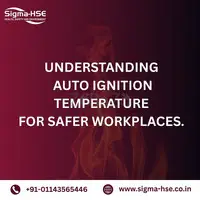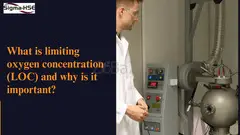Navigate
Popular search
Save this search
Save this search and get notified when new offers are posted.
71 results match your search criteria
Check with seller
Understanding Auto Ignition Temperature for Safer Workplaces. | Sigma HSE India
Learn what auto ignition temperature is, why it matters in industrial safety, and how knowing this critical value can help prevent fire and explosion hazards. Discover practical applications and tips for managing ignition risks in your facility. https://www.sigma-hse.co.in/auto-ignition-temperature
Located: Delhi, Delhi, IN
Check with seller
Is HIRA the Backbone of Workplace Safety? | Sigma HSE India
Yes, HIRA (Hazard Identification and Risk Assessment) is widely regarded as the backbone of workplace safety. It plays a crucial role in identifying potential hazards, evaluating associated risks, and implementing appropriate control measures before accidents or incidents occur. By proactively assessing risks, organiza...
Located: Delhi, Delhi, IN
Check with seller
What is HIRA and Why It’s Critical for Indian Industries?
HIRA (Hazard Identification and Risk Assessment) is a vital safety practice for Indian industries due to the country’s vast and diverse industrial landscape. From manufacturing plants and construction sites to chemical factories and mining zones, each sector in India is exposed to a unique set of hazards. With a high d...
Located: Delhi, Delhi, IN
Check with seller
What are the major steps in conducting a Hazard and Operability (HAZOP) study? | Sigma HSE
A Hazard and Operability (HAZOP) study is conducted through a systematic and structured process. The first step is to clearly define the scope of the study, including the specific plant section, system, or process to be analyzed, along with the objectives—such as identifying potential hazards and operational issues. On...
Located: Delhi, Delhi, IN
Check with seller
What Is HAZOP? | Sigma HSE India
HAZOP (Hazard and Operability Study) is a structured method used to identify potential hazards and operational issues in industrial processes. A team systematically examines the system using guide words like "more" or "none" to explore possible deviations from normal operation. This helps uncover risks, their causes, a...
Located: Delhi, Delhi, IN
Check with seller
Compare flash point and auto ignition temperature. How are they related? | Sigma HSE
Flash point is the lowest temperature at which a substance gives off vapors that can ignite with an external spark or flame. In contrast, auto ignition temperature (AIT) is the temperature at which a substance ignites on its own, without any external source. Flash point is always lower than AIT. For example, petrol has...
Located: Delhi, Delhi, IN
Check with seller
Dust Combustibility Testing | Sigma HSE
Dust explosion defines the rapid combustion occurs when dust dispersed in air, within the closed medium or confined space. Its depending on the following conditions, the dust must be combustible. If you want to know more about Dust Combustibility Testing, then you can visit on our site. https://www.sigma-hse.co.in/news...
Located: New Delhi, Delhi, IN
Check with seller
What are the main objectives of the risk analysis process? | Sigma HSE
The risk analysis process aims to identify potential risks, assess their impact and likelihood, and develop effective mitigation strategies. By systematically evaluating both internal and external threats, organizations can prioritize risks based on their severity and probability. This process enhances decision-making ...
Located: Delhi, Delhi, IN
Check with seller
What are the key elements of hazardous area classification? | Sigma HSE
Hazardous area classification involves several key elements to ensure safety in environments where flammable gases, vapors, dust, or fibers are present. The first element is identifying the type of hazardous substance, such as flammable gases (methane, propane) or combustible dusts (coal dust, grain dust). Next, zone c...
Located: Delhi, Delhi, IN
Check with seller
Layer Ignition Temperature (LIT) Testing | Sigma HSE
The Layer Ignition Temperature (LIT) test involves directly heating a compound in a Bunsen burner flame and observing the flame's characteristics. This test helps determine the type of bonding in an organic compound. Unsaturated compounds typically produce a sooty flame. If you want to know more about LIT, then you can...
Located: Delhi, Delhi, IN
Check with seller
What is limiting oxygen concentration (LOC) and why is it important? | Sigma HSE
Limiting Oxygen Concentration (LOC) is the minimum oxygen level in a gas mixture at which a substance, such as a flammable gas, vapor, or dust, can ignite or sustain combustion. If the oxygen concentration is reduced below this threshold, combustion cannot occur, even in the presence of an ignition source and fuel. LOC...
Located: Delhi, Delhi, IN
Check with seller
What industries require PSM implementation the most? | Sigma HSE
Process Safety Management (PSM) is essential in high-risk industries handling hazardous chemicals and complex operations. The oil and gas, chemical, pharmaceutical, and power generation sectors rely on PSM to prevent explosions, toxic releases, and fires. Mining, metals, food processing, pulp & paper, and semicondu...
Located: Delhi, Delhi, IN
Check with seller
What role does incident energy play in Arc Flash Hazard Analysis? | Sigma HSE
Incident energy plays a crucial role in Arc Flash Hazard Analysis as it determines the severity of an arc flash event and guides safety measures. Measured in cal/cm², incident energy represents the thermal energy a worker would be exposed to at a specific distance from the arc source. Higher incident energy levels indi...
Located: Delhi, Delhi, IN
Check with seller
How can probability distributions be used to estimate risks in QRA? | Sigma HSE
Probability distributions are vital in Quantitative Risk Assessment (QRA) as they model uncertainties and estimate risks numerically. Different distributions apply to various risks—normal for natural variations, lognormal for skewed risks, exponential for failure times, and Poisson for rare events. Monte Carlo simulati...
Located: Delhi, Delhi, IN
Check with seller
Process Safety Lab at IIT Hyderabad | Sigma HSE
Sigma-HSE Laboratory provides physico-chemical data on dusts, gases and vapour as per standards, together with expert interpretation from experienced and highly trained technicians and scientists who have worked in this field for over 30 years. Our laboratories generate test data on the flammability, explosivity & ...
Located: Delhi, Delhi, IN
Check with seller
Why is MIE important in industrial safety? | Sigma HSE
Minimum Ignition Energy (MIE) is crucial in industrial safety as it helps prevent fires and explosions by identifying ignition risks from sparks or electrostatic discharge. Industries handling flammable gases, vapors, or dust must control static electricity, use explosion-proof equipment, and follow safety regulations ...
Located: Delhi, Delhi, IN
Check with seller
What are the latest trends in process safety consulting in India? | Sigma HSE
Process safety consulting in India is growing due to stricter regulations, industrial safety focus, and technological advancements like automation and IoT. Industries such as oil, gas, chemicals, and pharmaceuticals seek expert consultants for compliance and risk management. The Asia-Pacific market, including India, is...
Located: Delhi, Delhi, IN
Check with seller
What parameters are considered in a lightning protection risk assessment? | Sigma HSE
A lightning protection risk assessment evaluates factors like lightning ground flash density, structure height, location, and materials to determine strike probability. It also considers human safety, economic impact, and environmental hazards. Key protective measures include surge protection, grounding systems, and li...
Located: Delhi, Delhi, IN
Check with seller
How is electrical risk assessment performed during an audit? | Sigma HSE
Electrical risk assessment during an audit involves inspecting wiring, circuit breakers, and grounding to identify faults and overloading. Load analysis ensures proper power distribution, while thermal imaging and insulation testing detect overheating and leakage risks. Arc flash and fault analysis help prevent fire an...
Located: Delhi, Delhi, IN
Check with seller
What are some common substances with very low minimum ignition energy (MIE)? | Sigma HSE
Substances with very low Minimum Ignition Energy (MIE) are highly flammable and can ignite from small sparks or static discharge. Hydrogen (0.02 mJ), acetylene (0.017 mJ), and ethylene oxide are among the most easily ignitable gases, while gasoline vapors, diethyl ether, and carbon disulfide (0.009 mJ) pose significant...
Located: Delhi, Delhi, IN
Check with seller
The Importance of Layer Ignition Testing (LIT) | Sigma HSE
Layer Ignition Testing (LIT) is essential for assessing the flammability of combustible dust layers, helping industries prevent fire and explosion hazards. It determines the minimum temperature at which dust can ignite, guiding safety measures like temperature monitoring and ventilation. Crucial in sectors like pharmac...
Located: Delhi, Delhi, IN
Check with seller
How is probability used in Quantitative Risk Assessment (QRA)? | Sigma HSE
In Quantitative Risk Assessment (QRA), probability is used to estimate the likelihood of hazardous events occurring and their potential consequences. It helps quantify risks by assigning numerical values to uncertain events, allowing for a more objective assessment. Probability distributions are used to model uncertain...
Located: Delhi, Delhi, IN
Check with seller
How does the presence of inert gases affect minimum ignition energy (MIE)? | Sigma HSE
The presence of inert gases, such as nitrogen, carbon dioxide, and argon, increases the Minimum Ignition Energy (MIE) by making ignition more difficult. This occurs because inert gases dilute the fuel-air mixture, reducing the concentration of flammable components and lowering the likelihood of combustion. Additionally...
Located: Delhi, Delhi, IN
Check with seller
How does an electrical safety audit help in preventing workplace accidents?
An electrical safety audit helps prevent workplace accidents by identifying potential hazards, ensuring compliance with safety regulations, and recommending corrective actions. It detects issues like faulty wiring, overloaded circuits, improper grounding, and equipment malfunctions that could lead to fires, electric sh...
Located: Delhi, Delhi, IN
Check with seller
How does technology improve hazard identification and risk assessment HIRA?
Technology enhances hazard identification and risk assessment (HIRA) by improving accuracy, efficiency, and real-time monitoring. AI and IoT sensors predict hazards and detect risks like gas leaks and equipment failures. Digital tools streamline reporting, while VR/AR simulations improve safety training. Drones and rob...
Located: Delhi, Delhi, IN

































